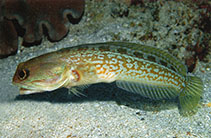| Family: |
Opistognathidae (Jawfishes) |
| Max. size: |
25 cm SL (male/unsexed) |
| Environment: |
demersal; marine; depth range 20 - 100 m |
| Distribution: |
Indo-West Pacific: eastern Australia to the Ryukyus, Taiwan, Philippines, Malaysia, and Indonesia. |
| Diagnosis: |
Dorsal spines (total): 11-11; Dorsal soft rays (total): 14-14; Anal spines: 3-3; Anal soft rays: 14-14; Vertebrae: 28-28. This species is distinguished by the following characters: elongated supramaxilla and posterior end of maxilla produced as a thin flexible lamina; upper jaw's inner lining and adjacent membranes with one or two conspicuous black stripes; dorsal half of dorsal fin usually dark except for narrow pale margin, remainder of fin pale and often with 8 or 9 evenly spaced dark blotches that extend onto basal fourth to third of fin and slightly onto dorsum; D XI,14; body with about 90-11 0 oblique scale rows; total gill rakers 28-35 (Ref. 81517). |
| Biology: |
Inhabits open sand and rubble substrates in about 20-25 meters (Ref. 48637). May be found in depths greater than 100 m (Ref. 559). Mouthbrooders (Ref. 240). |
| IUCN Red List Status: |
Least Concern (LC); Date assessed: 18 August 2023 Ref. (130435)
|
| Threat to humans: |
harmless |
Source and more info: www.fishbase.org. For personal, classroom, and other internal use only. Not for publication.
